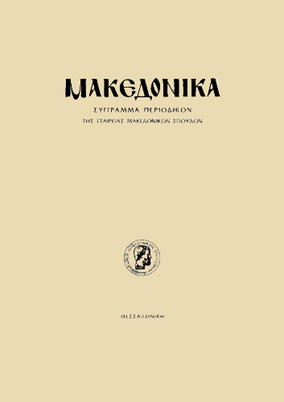Η "ιστορική τοιχογραφία" του ναού του αγίου Δημητρίου
Part of : Μακεδονικά ; Vol.34, 2004, pages 209-227
Issue:
Pages:
209-227
Parallel Title:
The «Historic Wall-Painting» of the Church of Saint Demetrius.
Section Title:
Articles
Abstract:
The so-called historic wall painting on the south wall of the Church of Saint Demetrius at Thessaloniki was executed on the occasion of a series of structural intervetions in the church. The left panel of the painting shows a man on horseback being received by people in front of a building and the right panel shows the interior of a church and frightened people inside fleeing the invading barbarians who pursue them. The majority of scholars accept that the panels are contemporary and re lated to each other. They also accept that the subject of the left panel is an em peror’s reception at the entrance of a city; all but one scholar admit that the city shown in both panels is Thessaloniki. The left panel emperor has gen erally been identified as Justinian II. The right panel is more difficult to inter pret. It has been argued that the action takes place in Thessaloniki or Sirmium and the invading barbarians have been interpreted alternatively as Slavs or Saracens. G. and M. Soteriou, who published the church of St Demetrius, suggested with reservations that the emperor in the left panel is Leo the Wise and the subject of the right panel pertains to the sack of Thessaloniki by the Saracens in 904. In order to arrive at a firm conclusion as to when and why the painting was made we will proceed to the examination of the structural interventions which made possible the creation of the painting. The intervention connected with the painting on the south wall of the church has been related with: a) the abolition of the SE entrance to the church and the erection in its place of St Euthymius chapel and b) the creation of the inner or small galleries. Both these interventions have been executed between the middle of the ninth (galleries) and the first half of the tenth century A.D. (St Euthymius chapel). On the other hand the emperor in the left panel can be identified with Leo the Wise with the help of a comparison with this emperor as he is shown in the narthex mosaic panel of Saint Sophia at Constantinople. Even though Leo never visited Thessaloniki the painting showing him entering the city can be interpreted as a symbolic representation of his beneficial gestures towards the city and the church of St Demetrius in the aftermath of the sack of 904 by the Saracens. Indeed, as we know from historical sources, the emperor paid a ransom for rescuing the city from fire and the emancipation of the Thessalonian captives. Furthermore, he con tributed to the renewal of the church of St Demetrius, as is proven by the interventions related with the painting and, most probably, he endowed the city with a new sea wall.
Notes:
856:https://ejournals.epublishing.ekt.gr/index.php/makedonika/article/view/6428, DOI: https://doi.org/10.12681/makedonika.873
Electronic Resources:




